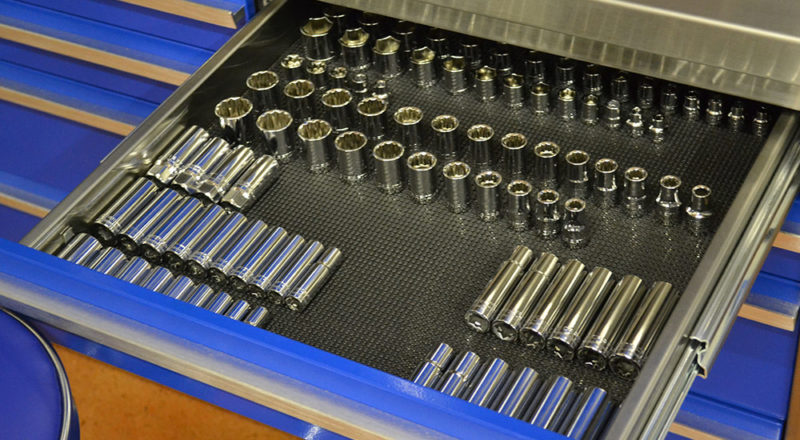
Tips To Get The Best Return-On-Investment From Your Garage Cabinets
When looking to purchase garage cabinets, here are a few ‘tips’ to getting the best return-on-investment and bang for your buck in selecting the
best cabinets to meet your space, storage and budgetary needs. Because the pricing of cabinets is often dependent upon what type of cabinet (doors or drawers) and their size, it may be helpful to know a few tricks of the trade.
MAXIMIZE CABINET SIZE – LIMIT QUANTITIES
Wherever practical, try to order the largest size cabinet possible. You may reasonable conclude that a quantity of two (2) 24”-wide cabinets equals the
same span as one (1) 48”-wide cabinet and that the costs therefore should be the same. However, because the manufacture has to machine twice the number of parts and will have twice the labor component to assemble those parts, the costs of two cabinets will always going to be inherently higher to you the consumer. Always buy big!
Larger cabinets may also be more efficient for some manufacturers. Cabinetmakers need to make the largest number of parts from the smallest amount of material. Generally speaking, large parts (associated with larger-sized cabinets) have greater material yield and therefore less waste compared to smaller parts, where yield may be lower and the amount of waste disproportionately higher.
You may also be thinking that you are purchasing the same amount of storage capacity, but you are actually sacrificing storage space if, for example, you are placing two (2) 24”-wide cabinets next to one another compared to one (1) 48”-wide cabinet. Both side walls, which are redundant because they are butted against each other, consumes storage space that a wider cabinet that is open does not lose. A smaller cabinet also limits what can be stored inside.
Lastly, because shipping costs can often be dependent on the quantity of the shipment, limiting the number of cabinets and maximizing their size may also save you in shipping costs.
INVENTORY YOUR NEED FOR DRAWERS
As a general rule, base cabinets with drawers will always be more costly to manufacturer than cabinets with doors because:
(a) Drawer bodies are inherently more challenging to manufacture than doors; and
(b) For every drawer body there are two drawer slides and a handle, so hardware costs can add up quickly. As an example, in an eight-drawer cabinet there are 16 drawer slides, eight drawer bodies and eight handles, which ends up being a lot of hardware assembled inside one cabinet. Whenever there are lots of parts, there will need to be the labor to assemble those parts together.
In short, the more drawers, the more expensive the cabinet.
Let’s cover what is stored in drawers and what size of drawer are generally available to help guide you toward selecting what size and quantity of drawers will best meet your needs:
Small-Height Drawers (like 3.5”-tall drawers) – These are perfect for storing small hand tools, such as socket sets, screwdrivers, wrenches, hammers and other similarly sized tools. These drawers are also ideal for storing fasteners, such as boxes of screws, nuts, bolts, washers, etc.
Medium-Sized Drawers (like 7”-tall drawers) – Are ideal for storing small power tools, such as cordless tools, handheld tools and air tools. Any handheld power tool that is battery operated, electric or power by air will fit conveniently into this type of drawer.
Tall-Height Drawers (7” & taller) – Taller drawers will more easily accommodate larger power tools like circular saws, sawzalls,
spray guns, handheld sanders and other bulky tools that are often challenging to store.
Taking an inventory and making a list of the items you intend to store in drawers will be valuable to selecting only the number of cabinets and drawers you need.
STAY AWAY FROM CORNERS
While corner base cabinets are a popular way in kitchens of merging one wall of cabinetry to another and allowing for a continuous, uninterrupted work surface, because the cabinet needs to be very deep and the front access door small in size, storage space in corners is ordinarily wasted. And because of their massive depth, it is not easy to access contents from the further reaches of these cabinets.
With corner cabinets you generally have high cost and lower return on investment when compared to other cabinets having similar cubic storage.
DID THIS HELP?
What we hope to accomplish through these blog articles is to share the knowledge and information that we have gained at VAULT® over a decade
of helping design garages and organizing their spaces and in doing so help readers make informed decisions.
COMPLEMENTARY CONSULTATION
If you would like assistance with organizing your space, VAULT® offers complimentary design consultations. We will work closely you to talk discuss your space, your overall objectives, storage needs, as well as any budget parameters that you would like us to work within so that you can create a custom solution that is just right for you.
Please call us at (310) 622-4477 and let’s begin a conversation about your newly organized garage.